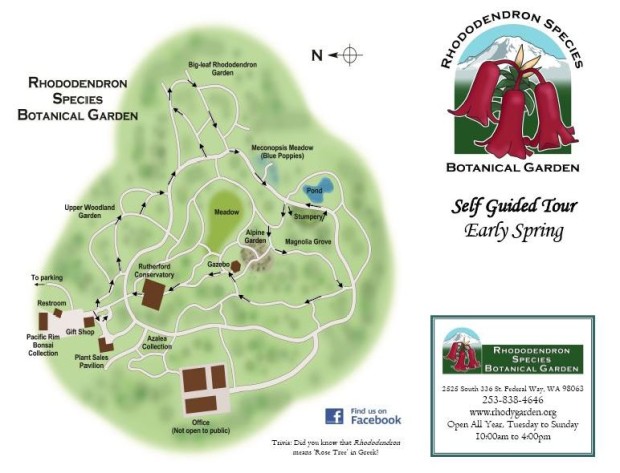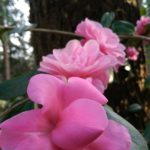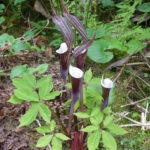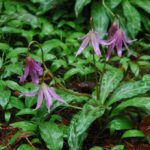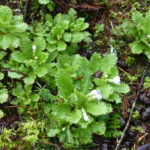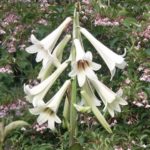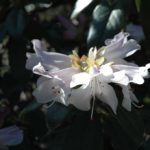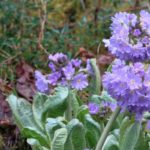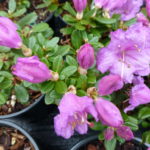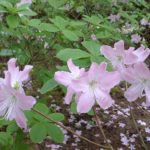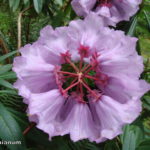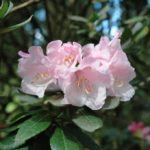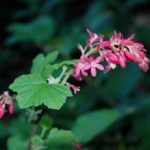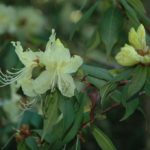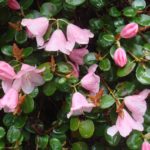Download Self Tour Early Spring 2015
- Camellia ‘Water Lily’
- Arisaema sikokianum
- Erythronium revolutum “Trout Lily”
- Primula moupinensis
- Cardiocrinum giganticum
- Paeonia mairei
- Fern Stumpery
- R. ciliatum
- Primula denticulata
- R. pemakoense
- R. schlippenbachii
- R. huianum
- R. pseudochrysanthum
- Ribes sanguineum
- R. lutescens Bagshot Sands
- R. williamsianum
Enter the courtyard and look to your right where you will see #1 Arisaema sikokianum*, Jack in the Pulpit. This strange-looking plant has a beautiful but unusual flower of dark purple and white. It is easily grown in the shaded garden. From the garden shop walk to your left and visit the clear pink-flowered #2 Rhododendron schlippenbachii, the Royal Azalea. This plant is famous for its beautiful flowers in early spring as well as the wonderful orange fall foliage color. Next to R. schlippenbachii is #3 Ribes sanguineum*, Flowering Currant. Native to the Northwest, this hummingbird favorite thrives in our climate and is adaptable to almost any garden situation.
Take the left path between the two deciduous magnolia trees and you are in the Upper Woodland Garden which features many species with thickly indumented leaf undersurfaces. The magnolia on your right is #4 Magnolia sargentiana var. robusta from China. This pink flowering magnolia has among the largest flowers of any magnolia. This plant is fairly uncommon in cultivation despite the large flowers and nice foliage. The one on your left is #5 Magnolia hypoleuca from Japan. Its cup-shaped creamy white flowers appear in June and its huge leaves grow up to one-and-a-half-feet long!
Keep going and you will see #6 Luzula sylvatica ’Aurea’ Golden Wood Rush. The evergreen grass-like leaves of this plant are gold green in the spring, maturing to lime green at the end of the season and adding wonderful color to a shady part of the garden. Next stop is the patch of #7 Primula moupinensis on your right. This is a very interesting ground-covering primrose from S. Si-chuan, China that spreads by sending numerous runners just like a strawberry. Pale pink flowers are produced in early spring. Continue straight ahead where you will see #8 Paeonia mairei on your left. This is a rare woodland species collected in the wild in China. This early spring-blooming peony enjoys shade unlike the common garden peony which requires full sun to thrive.
Let’s walk back to the main path and make a left turn. Pass the bamboo on your right and walk on to the next marked path on your left. This area is called the Big Leaf Garden. Most of the big-leafed rhododendrons eventually become very large trees in their native temperate rain-forests in the Sino-Himalaya. Follow the signs to take another left turn and notice the #9 Erythronium revolutum, Trout Lily on your right. These bulbs produce nodding pink flowers in spring. They are completely dormant by July.
Continue your tour to #10 Camellia ‘Water Lily’. Across from the camellia is a large patch of #11 Podophyllum pleianthum*, the Asian May Apple. This is a beautiful woodland plant with umbrella-like foliage. The plant is used medicinally in its native China. You should now be veering slightly to the right and headed back toward the main path. Continue forward to #12 Matteuccia struthiopteris*, the Ostrich Fern. The beautiful new growth of the emerging fiddleheads is quite striking.
Follow the sign to visit #13 Menziesia ciliicalyxwith white hanging bells. This rare deciduous shrub is closely related to rhododendrons. In fact, the common name is Mock Azalea. Back to the main path on your right is #14 Primula denticulata. This Himalayan species is known as the Drumstick Primrose and blooms for a long period each spring.
Now, make a left turn on the main path. You will see #15 Rhododendron huianum on your left. This species from China has strikingly colored flowers and new growth. Keep going until you see the Himalayan Blue Poppy meadow on your left. Check out the new growth of #16 Cardiocrinum giganteum* which looks similar to a shiny green hosta. This is the Himalayan Giant Lily which can grow to 12-feet tall with masses of six inch long fragrant flowers in June. The clusters of fuzzy leaves are the Blue Poppies*.
Keep going along the main path until you see the Hardy Fern Foundation’s Victorian Stumpery (#17) on your right. A stumpery is a Victorian period garden design that romanticizes nature. The design uses tree roots, placed on their sides or upside down. The tree roots are exposed creating a “Wild Scene” and then planted with thousands of ferns and other woodland plants.
From the stumpery, walk back along the main path toward the blue poppies and take an immediate left at #18 Rhododendron morii. Continue up the hill to #19 Rhododendron pachysanthum. This is one of the finest foliage plants in the ge-nus Rhododendron. Next stop is #20 Rhododendron pseudochrysanthum*. This species is closely related to R. pachysanthum. You can tell the difference by looking at the underside of the leaves. R. pseudochrysanthum has indumentum (fuzz on the underside of the leaves) on its midrib only whereas pachysanthum is thickly covered with indumentum. Now, walk up the hill to the Alpine Garden (#21). Please take some time to explore this unique garden area. Most of the plants here are found at high altitudes in the mountains of Asia. Follow the sign for self-guided tour and visit #22 Rhododendron pemakoense*, a dwarf species native to the Himalaya Mts.
Continue your tour past the beautiful #23 Rhododendron williamsianum*. This popular species has attractive pink bell-shaped flowers followed by the reddish new growth of the foliage. Keep going to visit #24 Magnolia Grove. This newly renovated area features a selection of large-flowered Asian magnolias planted to accent the flowers of the surrounding rhododendrons. It will be breathtaking in a few years when all of the magnolias begin to flower. Take a right at the end of the path to visit #25 Rhododendron ciliatum from the eastern Himalayas. Notice the beautiful reddish brown peeling bark. On your right is the yellow #26 Rhododendron lutescens.
Turn right toward the Gazebo then follow the sign for the Rutherford Conservatory (a separate self-guided handout is available to tour the Rutherford Conservatory). From here, you can walk back to the Garden Gift Shop where you started. Many of the plants you viewed today are available in the RSBG nursery area but are quite rare in regular retail nurseries. We hope you enjoyed the self guided tour today. Please come back and visit the garden soon!
* For sale at RSBG Nursery

